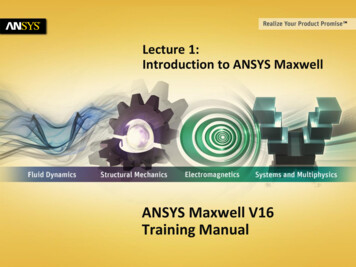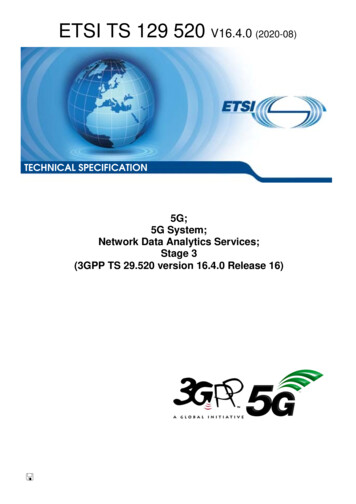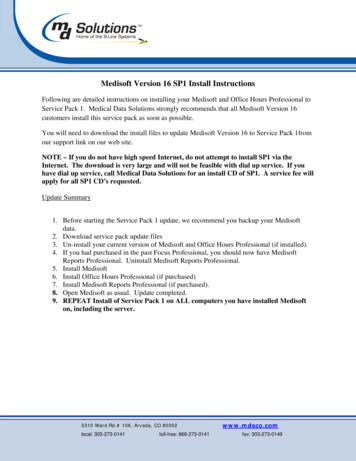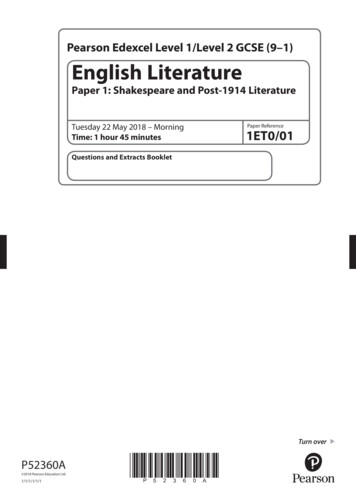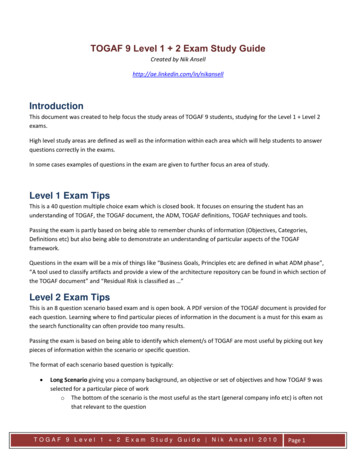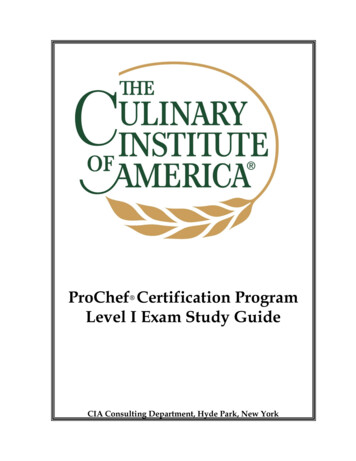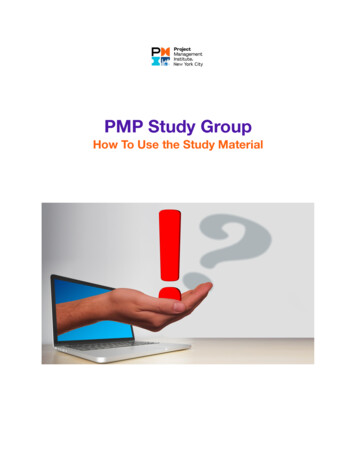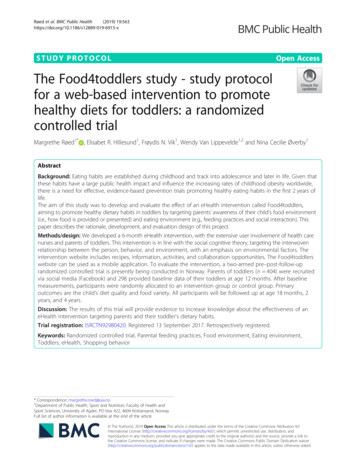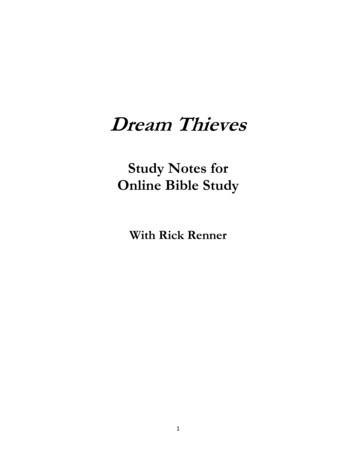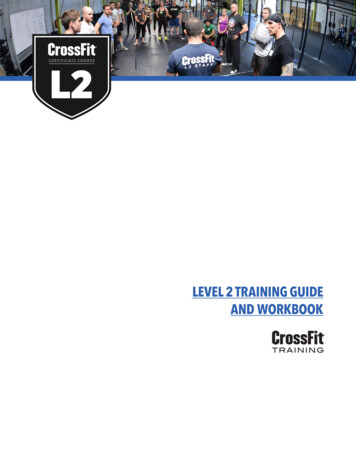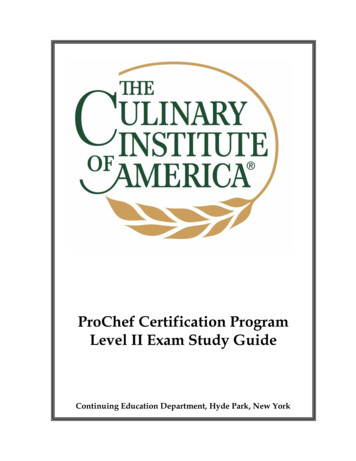
Transcription
ProChef Certification ProgramLevel II Exam Study GuideContinuing Education Department, Hyde Park, New York
Copyright 2008The Culinary Institute of AmericaAll Rights Reserveds manual is published and copyrighted by The Culinary Institute of America.Copying, duplicating, selling or otherwise distributing this product is hereby expresslyforbidden except by prior written consent of The Culinary Institute of America.
TABLE OF CONTENTSPOLICY ON ACADEMIC HONESTY. 1OVERVIEW PROCHEF CERTIFICATION PROGRAM LEVEL II EXAM CERTIFICATIONSTUDY GUIDE . 2PROCHEF CERTIFICATION LEVEL II COMPETENCIES . 3GENERAL EXAM INFORMATION . 4ADVISORS. 6SAMPLE EXAM SCHEDULES . 7LEVEL II PROCHEF EXAM STUDY GUIDE: SUPPORTING MATERIALS AND CLASSES. 11FOOD SCIENCE STUDY GUIDE . 16BASIC BAKING AND PASTRY STUDY GUIDE. 20BASIC BAKING AND PASTRY PRACTICAL EXAMINATION GUIDELINES . 23BASIC BAKING AND PASTRY PRACTICAL EXAMINATION STANDARDS OF QUALITY . 24PRACTICAL EXAMINATION SAMPLE TASTING SHEET. 25PRACTICAL EXAMINATION KITCHEN FLOOR SCORE SHEET . 26MEDITERRANEAN CUISINE STUDY GUIDE. 27MEDITERRANEAN CUISINE PRACTICAL EXAMINATION GUIDELINES . 30MEDITERRANEAN CUISINE PRACTICAL EXAMINATION STANDARDS OF QUALITY . 31PRACTICAL EXAMINATION SAMPLE TASTING SHEET. 32PRACTICAL EXAMINATION KITCHEN FLOOR SCORE SHEET . 33PERSONNEL MANAGEMENT STUDY GUIDE . 34HEALTHY CUISINE STUDY GUIDE . 36HEALTHY CUISINE PRACTICAL EXAMINATION GUIDELINES . 40HEALTHY CUISINE MENU DESIGN GUIDELINES. 41HEALTHY CUISINE PRACTICAL EXAMINATION STANDARDS OF QUALITY . 43PRACTICAL EXAMINATION SAMPLE TASTING SHEET. 49PRACTICAL EXAMINATION KITCHEN FLOOR SCORE SHEET . 50FINANCIAL SKILLS STUDY GUIDE. 51GARDE MANGER STUDY GUIDE . 52GARDE MANGER PRACTICAL EXAMINATION GUIDELINES . 55GARDE MANGER PRACTICAL EXAMINATION STANDARDS OF QUALITY . 57PRACTICAL EXAMINATION SAMPLE TASTING SHEET. 59PRACTICAL EXAMINATION KITCHEN FLOOR SCORE SHEET . 60PROCHEF CERTIFICATION PROGRAM LEVEL IIITHE CULINARY INSTITUTE OF AMERICA
POLICY ON ACADEMIC HONESTYAt The Culinary Institute of America, students are expected to develop their ownideas and to consult research materials in the process of their studies.Borrowing original ideas, recipes, research, or wording from other sourceswithout giving credit is plagiarism; using prepared materials from anorganization whose primary business is selling research papers is dishonest;submitting a paper prepared for one course to a faculty member in anothercourse without prior permission is cheating; copying from another source isstealing; presenting food or drink that was prepared by someone else forevaluation as your own and cheating in any form is dishonest. This behavior, orassisting anyone else in this behavior, represents a serious violation ofprofessional and academic standards at the CIA and will not be tolerated.Since such behavior is demeaning to the academic integrity of the degree andcertification programs, students who do not record the sources of theirinformation will fail that assignment and may be required to complete anotherequivalent assignment. Students who copy materials that are not their own andpresent that material as their own work will fail the assignment and possibly thecourse. Students found cheating will automatically fail the test or assignmentinvolved and may also fail the course.Serious violations of these standards will lead to suspension or dismissal fromthe CIA and its programs. A faculty member who identifies academicallydishonest behavior will tell the student about it, explain what is wrong, ask foran explanation, and inform the student of the consequences for the dishonesty.PROCHEF CERTIFICATION PROGRAM LEVEL II1THE CULINARY INSTITUTE OF AMERICA
OVERVIEWPROCHEF CERTIFICATION PROGRAMLEVEL II EXAM CERTIFICATION STUDY GUIDEThe ProChef Level II Exam evaluates the competency of candidates interested inachieving ProChef Level II Certification through The Culinary Institute of America’sProChef Certification Program. In addition to achieving certification, successfulcompletion of the program entitles candidates to 4.8 C.E.U.s.To qualify for this level of certification, candidates must demonstrate proficiency inculinary applications, leadership, and financial aptitude. Successful candidatesmust also display a sense of responsibility and dedication in all facets of their work.In addition to written and oral examinations, the Level II Exam consists of practicaltesting of the required competencies. Upon completion of the Level II Exam, thecandidate will have successfully demonstrated proficiency in the following areas: Food Science Basic Baking and Pastry Mediterranean Cuisine Management Skills Healthy Cuisine Financial Skills Garde MangerPROCHEF CERTIFICATION PROGRAM LEVEL II2THE CULINARY INSTITUTE OF AMERICA
PROCHEF CERTIFICATION LEVEL II COMPETENCIESThe ProChef Certification Program divides each certification level into threecompetency categories – culinary, leadership, and financial. The descriptions thatfollow are general skills and knowledge that a Level II candidate must possess inorder to achieve ProChef Level II Certification.CULINARY SKILLS Apply nutrition concepts to menu planning and recipes in order to meet nutritionalguidelines Apply fundamental baking techniques to produce breads, doughs, cakes andcustards Explain cooking fundamentals to others using basic food science terminology Apply the fundamentals of garde manger to prepare hot or cold hors d’oeuvre,salads, forcemeat terrines, and plated appetizers Identify key ingredients and flavor profiles of Mediterranean Cuisine Prepare key dishes of Mediterranean CuisineLEADERSHIP SKILLS Apply fundamental management principles Demonstrate effective supervision of others in work production by providing clearinstructions, effective criticism, and redirection Identify fundamental workplace laws and employer liability Prepare and conduct a performance review Prepare an effective work schedule taking into account multiple staff variablesFINANCIAL SKILLS Interpret a food operation P&L Apply concepts of menu mix and portion cost to produce a menu at a targeted foodcost Detect food and labor waste issues and develop a plan of corrective action Use and troubleshoot a food inventory and ordering systemPROCHEF CERTIFICATION PROGRAM LEVEL II3THE CULINARY INSTITUTE OF AMERICA
GENERAL EXAM INFORMATIONPRACTICAL EXAMINATIONSThe exam days are extended and will span the AM and PM class schedules. Sampleschedule sheets are provided in this document, as are sample judging forms. Youwill have the opportunity to review your score with the testing proctor. You mustbring your own knives, uniforms, and hand tools to the practical examinations.The Level II practical examinations cover: Basic Baking and Pastry Healthy Cuisine Mediterranean Cuisine Garde MangerFor each area of concentration, we have outlined suggested courses, textbooks,videos, key terms, and competencies to help prepare for each practical examination.WRITTEN EXAMINATIONSAll written examinations consist of 25 questions. You will receive one hour tocomplete each written examination. Level II written examinations cover: Food Science Basic Baking and Pastry Healthy Cuisine Management Skills Mediterranean Cuisine Financial Skills Garde MangerWithin this study guide, we have outlined suggested courses, textbooks, videos, keyterms, and competencies to help prepare for the written examinations.PROCHEF CERTIFICATION PROGRAM LEVEL II4THE CULINARY INSTITUTE OF AMERICA
WHAT ITEMS SHOULD I BRING WITH ME TO THE EXAM?Side towels, toques, and aprons are provided for your use and convenience. Youmust, however, supply the following items: Uniforms Kitchen shoes Knives Hand tools Calculator Personal reference books Recipes Laptop (optional)REQUIREMENTS FOR CERTIFICATIONTo achieve ProChef Certification, you must achieve a minimum total weighted scoreof no less than 75% for the entire assessment period. The breakdown of the totalweighted score is as follows: 65% of the average of the practical examination scores 35% of the average of the written examination scoresWRITTEN EXAMINATIONS If you score below 65% on up to two of the written examinations, you are stillconsidered a candidate for Certification. On the last day of the assessment, youwill be given an opportunity to retake the written examination(s) that you didnot pass. The highest achievable score on any retake exam is 75%. If you score below 65% on three or more written examinations, you are ineligiblefor certification for that assessment period. However, you may reapply for afuture ProChef Certification Exam.PRACTICAL EXAMINATIONS If you score lower than 65% on any practical cooking exam, you are ineligible forcertification for that assessment period. Unlike the written exams, you may notretake the practical examinations during an assessment period. However, you mayreapply for a future ProChef Certification Exam.PROCHEF CERTIFICATION PROGRAM LEVEL II5THE CULINARY INSTITUTE OF AMERICA
ADVISORSEach candidate is provided with an advisor who is familiar with the ProChefCertification process. Generally the advisors are assigned, but if you are familiar orhave worked with a specific chef or instructor before, you can request that chef orinstructor as your advisor.Your advisor is available to answer any questions you may have as you prepare andstudy for the examination. You will be provided with that person’s direct phoneextension and e-mail address. After initial contact, it will be your responsibility tocontact your advisor and seek advice and counsel. If you plan to take a course orvisit the campus, it would also be to your advantage to schedule a meeting withyour advisor at this time.The initial discussion with your advisor will focus on reviewing your application,determining the appropriate starting level, assisting you to develop an action plan,and answering any questions. At the conclusion of this conversation, your advisormay actually recommend that you not register for the exam at that time. You cannotregister for an exam without first having a conversation with your advisor.ProChef candidates that take full advantage of the advisor process are often highlysuccessful achieving their certification. Ultimately, it is your choice when to take theexam, but by following the recommendations of your advisor, you can ensure thatyou are fully prepared for the challenges of the exam.PROCHEF CERTIFICATION PROGRAM LEVEL II6THE CULINARY INSTITUTE OF AMERICA
SAMPLE EXAM SCHEDULESDay 0am -8:00amOrientation;Chef-InstructorDistribute Assignmentsfor the Week;Overview of ExamLecture Hall8:00am -9:00amDemonstration: ESHASoftwareChef-InstructorLecture Hall9:15am-2:15pmPractical Exam: BakingChef-InstructorLecture Hall2:15pm-3:00pmJudging BeginsChef-InstructorLecture Hall3:00pm – 4:00pmEvaluation, Feedback & Chef-InstructorReviewLecture Hall4:00pm-5: 00pmWritten Exam: BakingChef-InstructorLecture Hall5:00pm-6:00pmWritten Exam: FoodScienceChef-InstructorLecture Hall6:00pmIndependent Study Work Schedule Menu Assignments Prepare order list Begin CostingAssignmentsPlate DiagramsParticipantsOwn ChoicePROCHEF CERTIFICATION PROGRAM LEVEL II7THE CULINARY INSTITUTE OF AMERICA
Day 0am – 9:00amGarde Manger Prep Chef-InstructorKitchen9:30am –12:30pmPractical Exam:MediterraneanCuisineChef-InstructorSkills Kitchen12:30pm – 1:00pmWindow opensChef-InstructorLecture Hall1:00pm – 2:00pmEvaluation,Chef-InstructorFeedback & ReviewLecture Hall2:00pm – 3:00 pmWritten Exam:MediterraneanCuisineChef-InstructorLecture Hall3:00pm – 4:00pmWritten Exam:FinancialChef-InstructorLecture Hall4:00pm – 5:00pmIndependent Study ParticipantsPROCHEF CERTIFICATION PROGRAM LEVEL II8Own ChoiceTHE CULINARY INSTITUTE OF AMERICA
Day :00am – 9:00amGarde Manger PrepChef-InstructorKitchen9:00am –12:30pmPractical Exam:Healthy CuisineChef-InstructorSkills Kitchen12:30pm – 1:00pmWindow opensChef-InstructorLecture Hall1:00pm – 2:00pmEvaluation, Feedback& ReviewChef-InstructorLecture Hall2:00pm–3:00pmWritten Exam: Healthy Chef-InstructorCuisineLecture Hall3:00pm – 4:00pmWritten Exam:PersonnelManagementOwn ChoicePROCHEF CERTIFICATION PROGRAM LEVEL IIChef-InstructorParticipants9THE CULINARY INSTITUTE OF AMERICA
Day 00am –11:00amPractical Exam: Garde Chef-InstructorMangerSkills Kitchen11:00am – 11:15amWindow opensChef-InstructorSkills e Hall12:15pm –12:45pmEvaluation, Feedback & Chef-InstructorReviewParticipantsLecture Hall12:45pm-1:45pm* Written Exam : Make- Chef-Instructorup (if necessary)ParticipantsLecture Hall3:00pmGraduationDistribution ofCertificatesLecture HallPROCHEF CERTIFICATION PROGRAM LEVEL IIParticipantsChefsCE Department10THE CULINARY INSTITUTE OF AMERICA
LEVEL II PROCHEF EXAM STUDY GUIDE:SUPPORTING MATERIALS AND CLASSESAdditional information regarding the courses, books, and videos listed below, isavailable at http://www.prochef.comEDUCATIONAL PROGRAMS OFFERED AT THE HYDE PARK CAMPUS Mediterranean Cuisine: Ingredients and Techniques Charcuterie, Smokehouse, and Condiment Workshop Baking and Pastry for Chefs: Desserts and Breads From the Hot Kitchen Basic Bread Baking The Art and Science of Cooking Techniques of Healthy Cooking Frontline Leadership Skills Controlling Your Bottom Line Small Dishes, Big Flavors: Appetizers and First CoursesEDUCATIONAL PROGRAMS OFFERED AT THE GREYSTONE CAMPUS Charcuterie, Smokehouse, and Condiment Workshop Small Dishes, Big Flavors: Appetizers and First Courses The Cooking of Italy: From Tuscany to Sicily Mediterranean Cooking: An Advanced Course Healthy Flavors of Asia, Latin America, and the MediterraneanDISTANCE LEARNING Educational Programs at Cornell: School of Hotel rf-profdev.phpPROCHEF CERTIFICATION PROGRAM LEVEL II11THE CULINARY INSTITUTE OF AMERICA
RECOMMENDED TEXTBOOKS AND WORKBOOKSA Mediterranean Feast: The Story of the Birth of the Celebrated Cuisines of theMediterranean from the Merchants of Venice to the Barbary Corsairs. Wright,Clifford A. NY, NY: William Morrow and Company, Inc., 1999. ISBN 0-68815305-4American Dietetic Association Complete Food and Nutrition Guide, Second Edition.Roberta Larsen Duyff. New York, NY: John Wiley & Sons, Inc., 2002.ISBN: 0471-44144-9Baking and Pastry: Mastering the Art and Craft. The Culinary Institute of America.New York, NY: John Wiley & Sons, Inc. 2004. ISBN: 0-471-44382-4.Cookwise: The Hows and Whys of Successful Cooking. Corriher, Shirley. NY, NY:William Morrow, 1997. ISBN 0-688-10229-8Couscous and Other Good Food From Morocco. Wolfert, Paula. NY, NY: HarperCollins, 1987. ISBN 0-060-91396-7Culinary Math, Second Edition. Blocker, Linda and Julia Hill. New York, NY: JohnWiley & Sons, Inc., 2004. ISBN 0-471-46934-3Eat, Drink and Be Healthy: The Harvard Medical School Guide to Healthy Eating.Walter Willett and Patrick J. Skerrett. New York, NY: Free Press, 2005.ISBN: 074-3266420Flavors of the Riviera: Discovering Real Mediterranean Cooking. Andrews, Colman.NY, NY: Bantam Books, 1996. ISBN 0-553-09159-XFoundations of Food Preparation, Sixth Edition. Freeland-Graves, Jeanne Himichand Gladys C. Peckham. Englewood Cliffs, NJ: Merrill/Prentice-Hall, 1996.ISBN 0-023-39641-5Garde Manger: The Art and Craft of the Cold Kitchen, Second Edition. The CulinaryInstitute of America. New York, NY: John Wiley & Sons, Inc., 2000. ISBN 0-47146849-5Human Relations: Interpersonal, Job-Oriented Skills. Dubrin, Andrew J. UpperSaddle River, NJ: Prentice-Hall, Inc, 2001. ISBN 0-536-63753-9.Introducing Management. Schermerhorn, John R., Jr. and David S. Chappell.Hoboken, NJ: John Wiley & Sons, 2001. ISBN 0-471-13581-XPROCHEF CERTIFICATION PROGRAM LEVEL II12THE CULINARY INSTITUTE OF AMERICA
RECOMMENDED TEXTBOOKS AND WORKBOOKS CONT’DKitchen Science: A Guide to Knowing the Hows and Whys for Fun and Success inthe Kitchen. Hillman, Howard. Boston, MA: Houghton Mifflin Co., 1989. ISBN0-395-48072-8Managing Hospitality Human Resources, Third Edition. Woods, Robert H, Ph.D.East Lansing, MI: Educational Institute, American Hotel and LodgingAssociation, 2002. ISBN 0-86612-221-4Mediterranean Cooking. Wolfert, Paula. NY, NY: Ecco, 1999.ISBN 0-880-01402-4Mediterranean the Beautiful Cookbook: Authentic Recipes from the MediterraneanLands. Goldstein, Joyce; Peter Johnson and Ayla Esen Algar. San Francisco:Collins Publishers,1994. ISBN 0-002-55370-8Nutrition for Foodservice and Culinary Professionals, Fifth Edition. Drummond,Karen Eich and Lisa M. Brefere. Hoboken, NJ: John Wiley and Sons, 2003. ISBN0-471-41977-XOn Food and Cooking: The Science and Lore of the Kitchen, Second Edition.McGee, Harold. NY, NY: Macmillan Pub. Co., 2004. ISBN 0-020-34621-2Practical Baking, Fifth Edition. Sultan, William J. New York, NY: John Wiley & Sons,Inc.1990. ISBN: 0-471-28982-5.Principles of Food, Beverage, and Labor Cost Controls, 7th Edition. Dittmer, Paul R.NY, NY: John Wiley & Sons, Inc., 2003. ISBN: 0471397032Supervision in the Hospitality Industry Student Workbook. ProMgmt Program.Hoboken, NJ: John Wiley & Sons, 2003. ISBN 0-471-31350-5Supervision in the Hospitality Industry, Fourth Edition. Miller, Jack E., John R.Walker and Karen Eich Drummond. NY, NY: John Wiley & Sons, 2002.ISBN 0-471-39689-3The Baker’s Manuel, Fifth Edition. Amendola, Joseph and Nicole Rees. New York,NY: John Wiley & Sons, Inc. 2003. ISBN: 0-471-40525-6.The Curious Cook: More Kitchen Science and Lore. McGee, Harold. NY, NY:Macmillan USA, 1992. ISBN 0-020-09801-4PROCHEF CERTIFICATION PROGRAM LEVEL II13THE CULINARY INSTITUTE OF AMERICA
RECOMMENDED TEXTBOOKS AND WORKBOOKS CONT’DThe Essential Mediterranean: How Regional Cooks Transform Key Ingredients intothe World’s Favorite Cuisines. Jenkins, Nancy Harmon. NY, NY: HarperCollins, 2003. ISBN 0-060-19651-3The Mediterranean Diet Cookbook. Jenkins, Nancy Harmon and AntoniaTrichopoulou. NY, NY: Bantam Doubleday Dell, 1994. ISBN 0-553-09608-7The Professional Chef Study Guide, Eighth Edition. The Culinary Institute ofAmerica. New York, NY: John Wiley & Sons, Inc., 2006. ISBN 0471973009The Professional Chef , Eighth Edition. The Culinary Institute of America. NewYork, NY: John Wiley & Sons, Inc., 2006. ISBN 0764557343The Science of Cooking. Barham, Peter. NY, NY: Springer Verlag, 2001.ISBN 3-540-67466-7Time-Life Books’ Foods of the World Series 1, 2, 11, 13, and 18. Editors of Time-LifeBooks. NY, NY: Time-Life Books, 1968-1988. TrainingUnderstanding Baking, Third Edition. Amendola, Joseph and Nicole Rees. NewYork, NY: John Wiley & Sons, Inc. 2003. IBSN: 0-471-40546-9.RECOMMENDED VIDEOS AND DVDSCIA PresentsRemy FunfrockFrancois PayardBakeshop SeriesMeringuesVanilla Sauce and Pastry CreamBasic Steps of Baking BreadBread and Baker: From the Source SeriesProgram One: Traditions of French Bread BakingThe Basic Steps of Bread BakingFoie Gras SeriesThe Production of Foie GrasPreparing Foie GrasPROCHEF CERTIFICATION PROGRAM LEVEL II14THE CULINARY INSTITUTE OF AMERICA
RECOMMENDED VIDEOS AND DVDS CONT’DGarde Manger: The Art and Craft of the Cold Kitchen SeriesComposed SaladsPresenting Appetizers and Hors d’oeuvreGarde Manger: CondimentsTechniques of Healthy CookingThe Healthy Palate DVDThe Basics of Sauce Making SeriesEmulsion SaucesAromatic and Flavoring CombinationsPopular Cream and Filling (Les Cremes Populaire)Recipe Costing The Bottom LineSanitation Is not an OptionPROCHEF CERTIFICATION PROGRAM LEVEL II15THE CULINARY INSTITUTE OF AMERICA
FOOD SCIENCE STUDY GUIDEUse the following list of competencies, key terms, recommended reading materials,and videos to prepare for the Food Science Written Examination. The writtenexamination will consist of 25 questions. You will have one hour to complete theexamination.FOOD SCIENCE COMPETENCIESSuccessful candidates are able to. describe how stable emulsions are formed. diagram an emulsion. identify the continuous and dispersed (discontinuous) phases of each emulsion. list two types of emulsions. explain how emulsions are thickened and thinned. explain the term “emulsifying agent” and identify two major categories. list three reasons why emulsions break. identify the five main pigments found in vegetables, describing whether theyare water or fat soluble. describe the colors typical of each vegetable pigment. discuss how plant pigments are affected by changes in environment (exposureto heat, sugar, salt, acids and bases). explain proper cooking techniques to minimize loss of texture, flavor and colorin plant product identify the smaller chemical group that make up protein molecules. describe the various roles of protein in food preparation. diagram globular and fibrous protein. explain denaturation and coagulation. identify substances that speed and delay egg protein coagulation. explain the differences between a soft custard (sol) and baked custard (gel).PROCHEF CERTIFICATION PROGRAM LEVEL II16THE CULINARY INSTITUTE OF AMERICA
list examples of fibrous protein. discuss three ways meat is made tender before cooking. explain why collagen is the most important connective tissue. explain why fish muscle cooks more quickly than land animal muscle tissue. describe maillard browning. discuss what happens to meat when it is heated too rapidly or for too long. summarize the effects of heat, acid, salt and enzymes in meat cookery. explain the two basic methods by which starch is cooked. diagram a starch granule, identifying the two starch molecules it contains. summarize the most important characteristics of high amylose starches. summarize the most important characteristics of high amylopectin starches. describe gelatinization, pasting, and retrogradation of starch, indicating if itinvolves wet or dry heat. discuss three elements that interfere with starch thickening. describe the three classes of leavening. explain how air and steam work to leaven baked goods. name the gas which is created during chemical leavening. identify four methods by which air is incorporated into dough and batter. discuss baking soda, giving the requirements for its development into gas. describe the effects of unreacted baking soda in baked products. discuss double-acting powder, giving the requirements for its reaction. describe the function of yeast in baking, giving three environmental conditionsfor its optimal development. describe gluten and its role in baking. compare high and low protein flours.PROCHEF CERTIFICATION PROGRAM LEVEL II17THE CULINARY INSTITUTE OF AMERICA
KEY TERMSAcidAlbuminBaking powderBrineCarbohydrateCarry-over cookingCelluloseChlorophyllCoagulationConnective tissueDenaturationDouble-acting baking powderEmulsifierEnzymeFibrous othesisLactaseLeavenerLipidMaltoseModified starchOil-in-water emulsionOsmosisPermanent emulsionPhenolasePigmentProteinSemi-permanent osityYeastPROCHEF CERTIFICATION PROGRAM LEVEL IIActinAmino acidBaseCaramelizationCarotenoidsCaseinChemical leavenerChromoplastCollagenControlDextrinDry nGlobular proteinGlutenHydrophilicHygroscopicityInvert sugarsLactoseLecithinMaillard reactionMechanical leavenerMyoglobinOrganic dationSingle-acting baking powderSolSoluteSucroseSyneresisTemporary emulsionWater-in-oil emulsion18THE CULINARY INSTITUTE OF AMERICA
RECOMMENDED READINGCookwise: The Hows and Whys of Successful CookingThe Curious Cook: More Kitchen Science and LoreFoundations of Food Preparation, Sixth EditionKitchen Science: A Guide to Knowing the Hows and Whys for Fun and Successin the KitchenOn Food and Cooking: The Science and Lore of the Kitchen, Second EditionThe Science of CookingRECOMMENDED VIDEOS AND DVDSThe Basics of Sauce Making SeriesEmulsion SaucesPROCHEF CERTIFICATION PROGRAM LEVEL II# 247119THE CULINARY INSTITUTE OF AMERICA
BASIC BAKING AND PASTRYSTUDY GUIDEUse the following list of competencies, key terms, recommended reading materials,and videos to prepare for both the Baking and Pastry Written and PracticalExaminations.The written examination will consist of 25 questions. You will have one hour tocomplete the written examination.The practical examination will take five hours to complete. Please refer to theguidelines and quality standards outlined in the following pages for more detailedinformation. An instructor will contact you one week prior to the exam to informyou of your assigned items.BASIC BAKING AND PASTRY COMPETENCIESSuccessful candidates are able to. prepare basic breads. prepare basic pastry batters. prepare basic cakes. prepare pie dough. prepare custards. identify key ingredients and equipment in the bakeshop. accurately scale recipes up or down. demonstrate the use of baking and pastry equipment. demonstrate accuracy in weights and measures. demonstrate the use of baker’s percent. categorize baking ingredients as liquefiers or stabilizers. explain the functions of basic baking ingredients.PROCHEF CERTIFICATION PROGRAM LEVEL II20THE CULINARY INSTITUTE OF AMERICA
list the steps of the creaming, foaming, straight and cut-in mixing methods. list the steps of the bread making process. name and describe three techniques for making a meringue. compare and contrast the three different types of leaveners. describe the differences between flaky dough and mealy dough. identify the ratios and/or formulas for pie dough, cookie dough, pastry cream,pâte à choux and genoise. compare and contrast rich doughs and lean doughs.KEY TERMS1-2-3 dough / Cookie doughActive dry yeastBaking blindBatterBasic pie dough (3-2-1 dough) / Pâte briséeBavarian cream / BavaroiseBench restBench scraperBigaBloomButtercreamCake flourCaramelizationCarbon dioxideChemical leavenerClear flourCoagulationConvection ovenConventional ovenCream puffsCreaming methodCrumbCustardDeck ovenDenaturationDockingDrum sieve / TamisÉclairsEgg washFermentationFlakyFoaming iadinGlutenGluteninHard/Soft wheatHearth ovenHigh-ratio cakesInstant dry yeastKneadingLameLean doughLeavenersLiaisonMealyMeringueMise en placeMousseNappéOrganic leavenerParchment paperPastry cream / Crème patisseriePROCHEF CERTIFICATION PROGRAM LEVEL II21THE CULINARY INSTITUTE OF AMERICA
Pastry flourPâte sucréePeelPrecooked batterProfiterolesRestRich doughScalingSiftingShortenersSourdoughStraight mixing methodSteam-injected ovenTemperThickenersVanilla sauce / Crème AnglaisePâte à chouxPatent flourPhysical leavenerPre-fermentProofRetrogradationRubbed-dough methodScoringSweetenersSimple syrupSpongeStabilizerSweetenersTenderizerTwo-stage methodYeastRECOMMENDED READINGBaking and Pastry: Mastering the Art and CraftCulinary MathPractical Baking, Fifth EditionThe Professional Chef , Eighth EditionThe Baker’s Manual, Fifth EditionUnderstanding Baking, Third EditionCh. 1 - 2, 13pp. 163 - 165Ch. 3, 5,7 - 10, 14Ch. 34 - 38Ch. 2, 4 - 6, 12Ch. 12, 14 - 16RECOMMENDED VIDEOSThe Bakeshop SeriesMeringuesVanilla Sauce and Pastry CreamBasic Steps of Baking Bread# 2818# 2754# 1701Bread and Baker: From the Source SeriesProgram One: Traditions of French Bread Baking# 891PROCHEF CERTIFICATION PROGRAM LEVEL II22THE CULINARY INSTITUTE OF AMERICA
BASIC BAKING AND PASTRYPRACTICAL EXAMINATION GUIDELINESFor this practical examin
PROCHEF CERTIFICATION PROGRAM LEVEL II 3 T HE CULINARY INSTITUTE OF AMERICA PROCHEF CERTIFICATION LEVEL II COMPETENCIES The ProChef Certification Program divides each certification level into three competency categories – culinary, leadership, and financial. The descriptions that
